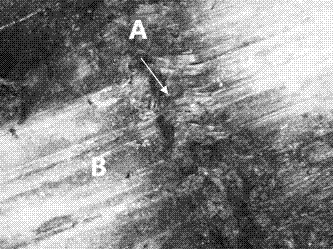Pseudomonas strain for preventing and treating kiwifruit canker and application of pseudomonas strain
A technology for kiwifruit canker and Pseudomonas, applied in the field of microorganisms, can solve the problems affecting the field control effect of canker, the problem of drug resistance of canker bacteria, etc., and achieves the effects of stable nature, strong inhibitory effect and remarkable effect.
- Summary
- Abstract
- Description
- Claims
- Application Information
AI Technical Summary
Problems solved by technology
Method used
Image
Examples
Embodiment 1
[0025] Example 1 Isolation and screening of Pseudomonas CCTCC M2016556
[0026] The Pseudomonas CCTCC M2016556 bacteria source of the present invention comes from wild kiwi branches in Jinggangshan, Jiangxi, the altitude of the sampling point is 1414m, and the longitude and latitude are N26°36'30, E114°07'33;
[0027] The separation method is: 1. Rinse the collected kiwi branches with clear water, disinfect the surface with 75% alcohol, air-dry at room temperature, cut an appropriate amount of sample with a sterilized blade, put it into a grinding bag, add an appropriate amount of normal saline, grind, After soaking for 3 minutes, take 100 μL of the supernatant of the plant grinding liquid and add it to the newly prepared KB medium, and use an inoculation loop to coat and streak.
[0028] The purification method is as follows: After cultivating the sample petri dish at room temperature for a certain period of time, wait for the colonies to grow in the dish, pick the colonies w...
Embodiment 2
[0029] Example 2 Identification of Pseudomonas CCTCC M2016556
[0030] 1. Observation of culture status
[0031] Activate the preserved strains on KB solid medium, culture them at room temperature, observe the growth of the colonies, and record the characteristics of the colonies, including color, growth speed, shape, texture, etc.
[0032] It is finally found that the Pseudomonas CCTCC M2016556 strain of the present invention is milky white, colloidal, with a smooth and moist surface, a raised center, neat edges, and normal viscosity; its strain morphology is shown in figure 1 Shown; its scanning electron microscope picture is shown in figure 2 shown.
[0033] 2. Molecular biological identification
[0034] DNA extraction: use bacterial PCR universal primer 27F (primer sequence is:
[0035] Eubac27F[106]5'-AGAGTTTGATCMTGGCTCAG-3') and 1492R (primer sequences are:
[0036] Eubac1492R[106]5'-TACGGYTACCTTGTTACGACT-3') amplified the 16S rDNA of the strain, and the length of...
Embodiment 3
[0037] Example 3 Screening of antagonistic bacteria for kiwifruit canker
[0038] 3.1 Test material
[0039] Actinidia endophytes isolated from kiwifruit samples collected from Dongshanfeng in Hunan Province, Jinggangshan in Jiangxi Province and Sichuan Province.
[0040] The pathogenic bacteria of kiwifruit canker for testing: Pseudomonas syringae pv.Actinidiae, the pathogen of kiwifruit bacterial canker isolated and identified by Sichuan Natural Resources Science Research, is shown in Table 1:
[0041] Table 1 Pathogens tested
[0042] Numbering Canker disease (Pseudomonas syringae pv.actinidiae.Psa) strains tested PC psa2012DJY P1 psa2013DJY P6 psa2013PJ 155 psa2014EB 185 psa2014YJ 206 psa2014QL
[0043] Screening of endophytic antagonistic bacteria against kiwifruit canker:
[0044] In this experiment, the Oxford cup method was used to screen the endogenous antagonistic bacteria of kiwifruit canker. The specific steps a...
PUM
 Login to View More
Login to View More Abstract
Description
Claims
Application Information
 Login to View More
Login to View More - R&D
- Intellectual Property
- Life Sciences
- Materials
- Tech Scout
- Unparalleled Data Quality
- Higher Quality Content
- 60% Fewer Hallucinations
Browse by: Latest US Patents, China's latest patents, Technical Efficacy Thesaurus, Application Domain, Technology Topic, Popular Technical Reports.
© 2025 PatSnap. All rights reserved.Legal|Privacy policy|Modern Slavery Act Transparency Statement|Sitemap|About US| Contact US: help@patsnap.com



